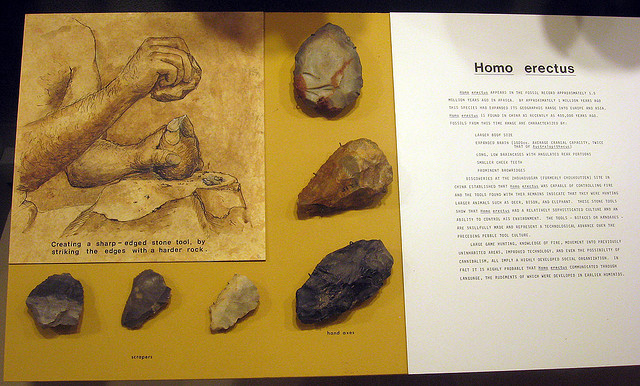Homo erectus and the paradox of human tools:

Over the weekend, at the Earth Day tweetup at the Science Museum of Minnesota, I heard an interesting fact: Human beings are now the dominant agent of landscape change on this planet, more than any natural process. (That's right. Suck it, glaciers!)
We tend to think of this kind of thing as a result of modernity. But I think that's only partly true. Modern technology has given us the tools that enable us to change the landscape of Earth in massive ways we weren't capable of in the past. But throughout human existence—even before we were technically human—we have made relatively large alterations to the world. It's not like human beings woke up one day and thought, "Hey, it's the 20th century, let's start messing around with stuff!" In reality, what makes our modern impact on the planet different from past—other than scale—is mainly that we've developed more self-awareness about our impact on the planet, and have actually started talking about whether we like the side effects those impacts bring.
Case in point: A recent study of ancient African animal species that suggests our ancestors drove a huge proportion of fauna to extinction basically as soon as they were technologically capable of doing so. Here's how Ann Gibbons described it at Science Now:
After comparing fossils of 78 species of carnivores that lived during five different periods of time between 3.5 million years ago (when large carnivores were at their peak) and 1.5 million years ago, Werdelin found that all but six of 29 species of large carnivores (animals that weighed more than 21.5 kilos) had gone extinct in that time. Moreover, the mass extinction began just before H. erectus appeared in the fossil record 1.9 million years ago. He also found that the community of carnivores alive 2.5 million to 2 million years ago ate a much broader range of food—with species within a community filling a wider range of dietary niches. By 1.5 million years ago, just hypercarnivores that ate only meat, such as lions and leopards, had survived while omnivores that scavenged and ate a wider range of foods, like civets, had disappeared. "Even I was surprised by the dramatic drop," Werdelin says.
Those omnivores that went extinct were in direct competition for scavenged carcasses with hominins.
This sounds kind of depressing, but I think it should actually make us feel a bit optimistic. Two million years ago, Homo erectus might have killed off 23 species of large carnivores. They had the tools to hunt and the desire to eat. But, even if they'd wanted to, those H. erectus wouldn't have had the tools necessary to organize other H. erectus' and better manage their own use of natural resources.
And that brings me to another interesting point that folks from the Science Museum of Minnesota kept making over and over at the Earth Day event. Modern life has created some pretty serious environmental challenges. But, at the same time, it's also put us in a much better position to deal with those challenges. Humans today are better educated, healthier, wealthier, and better connected with one another than any humans that have ever lived before. Our tools have helped us create some pretty big problems. But our tools are also exactly what we need to solve those problems.
Read the rest of the article at Science Now
Image: Homo erectus tools, a Creative Commons Attribution Share-Alike (2.0) image from hmnh's photostream
No comments:
Post a Comment